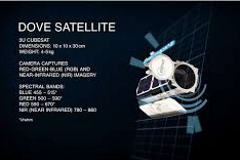The PlanetScope satellite constellation consists of 200+ DOVE (DOVEs and SuperDOVEs) satellites able to image all Earth's land every day (a daily collection capacity of 200 million km²/day) at 3-meter resolution. Each DOVE cubesat operates in four bands - red, green, blue and near infra-red.
Recently launched SuperDoves satellites introduced significant changes and upgrades. They can bring down about four times more data than the Doves, an increase that has allowed to widen the swath (or field of view) by 30 percent, double the number of spectral bands (or colors) to eight, and improve the radiometry (how accurately we can measure the brightness of the light reflected back from the Earth in each pixel). This is expected to significantly improve the precision and consistency of analysis or science fueled by this data.
In addition, these spectral bands have been chosen specifically to allow for interoperability with the Planetscope archive, the Landsat and Copernicus Earth observation programs, and the RapidEye constellation, the latter of which the SuperDoves will ultimately replace.
NEWS:Next Generation PlanetScope are now available.
Starting from March 1, 2022 Planet has announced the availability of Next Generation PlanetScope with Eight Spectral Bands and Quality Improvements.
PlanetScope will now include 8 spectral bands in addition to more important enhancements like improved sharpness, fewer sensor artifacts and calibration with Sentinel-2 enhancing spectral band alignment. PlanetScope data now includes the coastal blue, yellow, a second green, and red edge spectral bands to provide deeper understanding of physical change.
PlanetScope imagery archive starts from year 2009.
Contact us for further info about monitoring applications and how to buy writing at sales @ planetek.it (without blank spaces)

